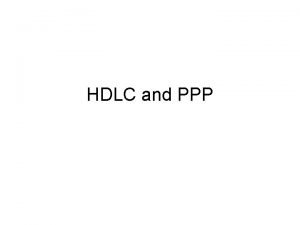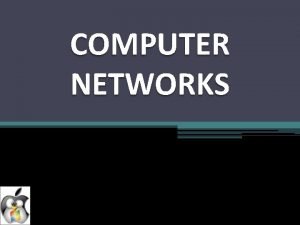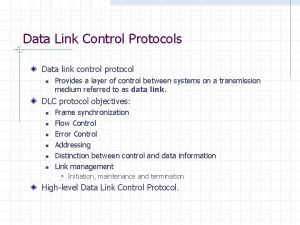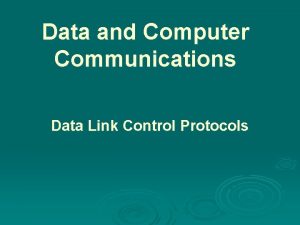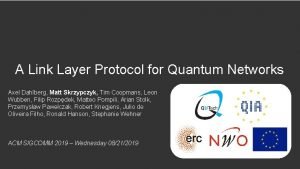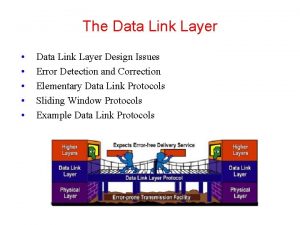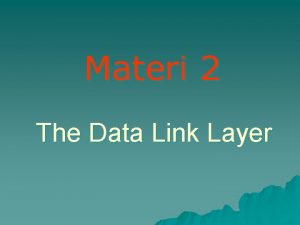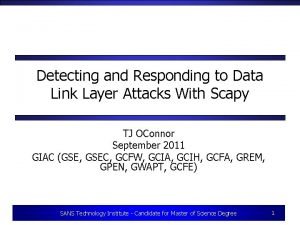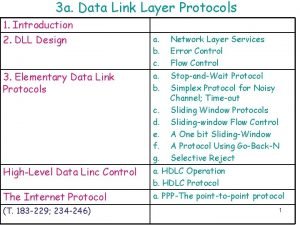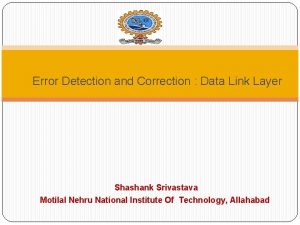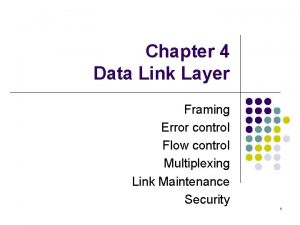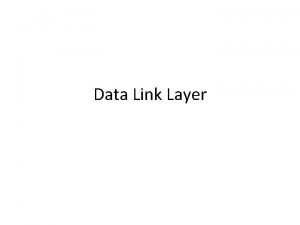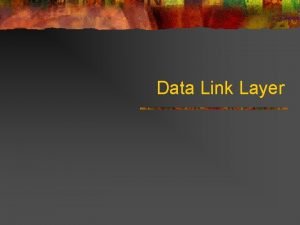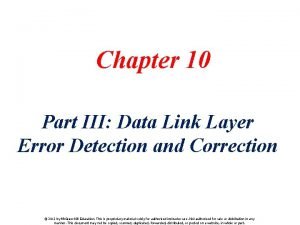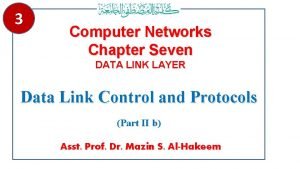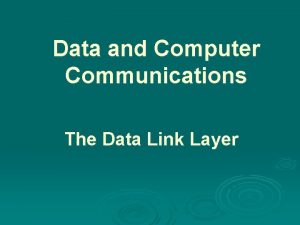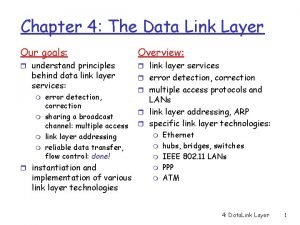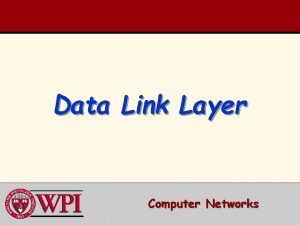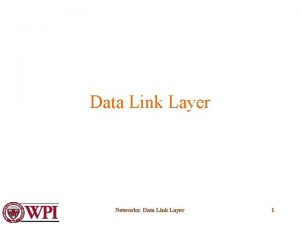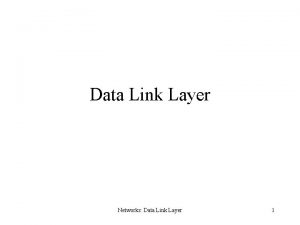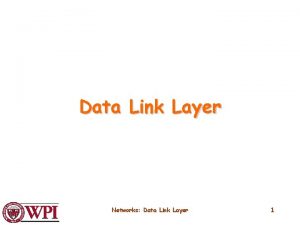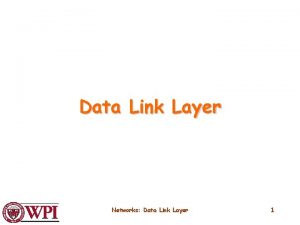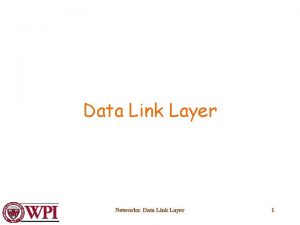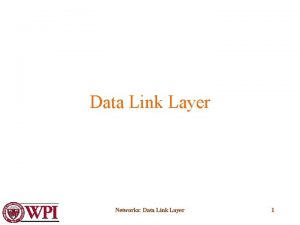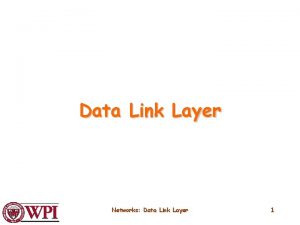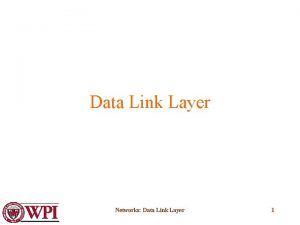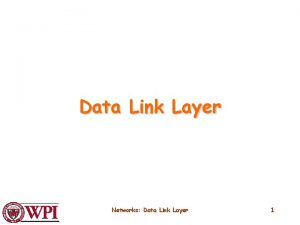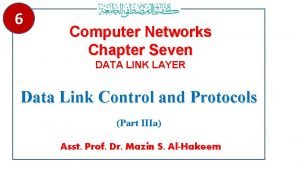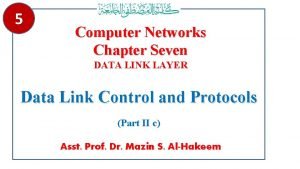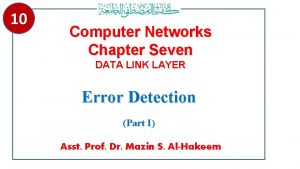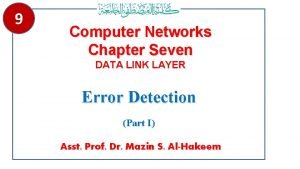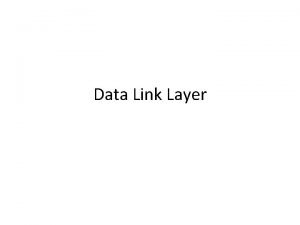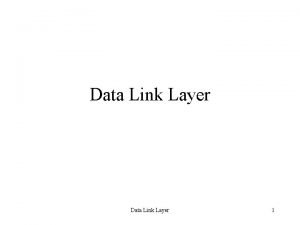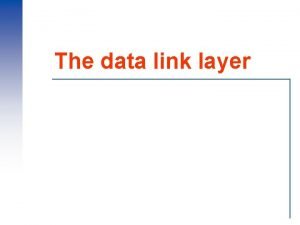1 Computer Networks Chapter Seven DATA LINK LAYER



























- Slides: 27

1 Computer Networks Chapter Seven DATA LINK LAYER Data Link Control and Protocols (Part I) Asst. Prof. Dr. Mazin S. Al-Hakeem

Data Link Control and Protocols (I) g n i m Fra g n i m a r F e z i S d e Fix g n i m a r F e z i S e l b a Vari Protocols Noiseless Channels Protocols Noisy Cha nnels Pro tocols Flow and Error Control Flow Control Error Control

7. 1 - Introduction The two main functions of the data link layer are data link control and media access control The second function of the data link layer is media access control, or how to share the link.

7. 1 - Introduction The two main functions of the data link layer are data link control and media access control The first function, data link control, deals with the design and procedures for communication Data link control functions between two adjacent nodes: node include framing, flow and -to-node communication. error control, and software implemented protocols that provide smooth and reliable transmission of frames between nodes.

7. 1 - Introduction The two main functions of the data link layer are data link control and media access control The first function, data link control, deals with the design and procedures for communication To implement between two adjacent nodes: node data link -to-node communication. control, we need protocols Each protocol is a set of rules that need to be implemented in software and run by the two nodes involved in data exchange at the data link layer.

7. 2 - Framing (The 1 st Function) The data link layer pack bits into frames, so that each frame is distinguishable from another. Our postal system practices a type of framing. The simple act of inserting a letter into an envelope separates one piece of information from another; the envelope serves as the delimiter. Framing in the data link layer separates a message from one source to a destination, by adding a sender address and a destination address. The destination address defines where the packet is to go; the sender address helps the recipient acknowledge the receipt.

Although the whole message could be packed in one frame; this is not normally done. One reason is that a frame can be very large, making flow and error control very inefficient. When a message is carried in one very large frame, even a single-bit error would require the retransmission of the whole message. When a message is divided into smaller frames, a single-bit error affects only that small frame.

Framing Fixed-Size Framing In fixed-size framing, there is no need for defining the boundaries of the frames; the size itself can be used as a delimiter. An example of this type of framing is the ATM wide-area network (WAN), which uses frames of fixed size called cells. Variable-Size Framing In variable-size framing, we need a way to define the end of the frame and the beginning of the next. Our main discussion in this chapter concerns variable-size framing, prevalent in local area networks (LAN). Historically, two approaches were used for this purpose: a character-oriented approach and a bit-oriented approach.

Framing Fixed-Size Framing Variable-Size Framing Character-Oriented Approach Character -oriented framing was popu lar when only text was exch anged by the data l ink layers. In a character-oriented protocol, Data to be carried are 8 -bit characters from a coding system such as ASCII code. The header, which normally carries the source and destination addresses and other control information, and The trailer, which carries error detection or error correction redundant bits, are also multiples of 8 bits.

Framing Fixed-Size Framing Variable-Size Framing Character-Oriented Approach To separate one frame from the next, an 8 -bit flag is added at the beginning and the end of a frame. The flag, composed of protocol-dependent special characters, signals the start or end of a frame.

Framing Fixed-Size Framing Variable-Size Framing Character-Oriented Approach The flag could be selected t be any ch o aracter n ot used f text comm or unication To separate one frame from the next, an 8 -bit flag is added at the beginning and the end of a frame. The flag, composed of protocol-dependent special characters, signals the start or end of a frame.

Framing Fixed-Size Framing Variable-Size Framing Bit-Oriented Approach Character -oriented framing f was popu raming lar when text, gra audio, vi phic, deo, and exchange s d by the d o on was ata link la yers. In a bit-oriented protocol, The data section of a frame is a sequence of bits to be interpreted by the upper layer as text, graphic, audio, video, and so on. However, in addition to headers (and possible trailers), we still need a delimiter to separate one frame from the other.

Framing Fixed-Size Framing Variable-Size Framing The flag is a special 8 flag 0111 -bit pattern 1110 Bit-Oriented Approach Most protocols use a special 8 -bit pattern flag 01111110 as the delimiter to define the beginning and the end of the frame

Bit Stuffing flag 01111 110 If the flag pattern appears in the data, we need to somehow inform the receiver that this is not the end of the frame. We do this by stuffing 1 single bit (instead of 1 byte) to prevent the pattern from looking like a flag. The strategy is called bit stuffing. In bit stuffing, if a 0 and five consecutive 1 bits are encountered, an extra 0 is added. This extra stuffed bit is eventually removed from the data by the receiver. Note that the extra bit is added after one 0 followed by five 1 s regardless of the value of the next bit. This guarantees that the flag field sequence does not inadvertently appear in the frame

Bit Stuffing Figure : Bit stuffing and unstuffing

g n i m a Fr g n i m a r F ed-Size Fix g s n r i e t m c a a r r a F ch ze i l S a i c e l e b p s a i Var h c a o r pp A d e t n e i r O r e t c a r Cha 110 1 1 0 h c a o r p p A d e t n e i g r n i f f u t Bit-O S Bit

7. 5 - Flow and Error Control (The 2 nd Function) The most important responsibilities of the data link layer are flow control and error control. Collectively, these functions are known as data link control Error control is both error detection and error correction. It allows the receiver to inform the sender of any frames lost or damaged in transmission and coordinates the retransmission of those frames by the sender. Flow control refers to a set of procedures used to restrict the amount of data that the sender can send before receiving an acknowledgment , and is one of the most important duties of the data link layer.

7. 5 - Flow and Error Control (The 2 nd Function) 7. 5. 1 - Flow Control t s u m a t a d f o w o o t l f d e e w Th o l r l e a v e i e c e r not b e h t m l e h w over Flow control refers to a set of procedures used to restrict the amount of data that the sender can send before receiving an acknowledgment ,

7. 5 - Flow and Error Control (The 2 nd Function) 7. 5. 1 - Flow Control Any receiving device has a limited speed at which it can process incoming data and a limited amount of memory in which to store incoming data. The receiving device must be able to inform the sending device before those limits are reached and to request that the transmitting device send fewer frames or stop temporarily. Incoming data must be checked and processed before they can be used.

7. 5 - Flow and Error Control (The 2 nd Function) 7. 5. 1 - Flow Control The rate of such processing is often slower than the rate of transmission. For this reason, each receiving device has a block of memory, called a buffer, reserved for storing incoming data until they are processed. If the buffer begins to fill up, the receiver must be able to tell the sender to halt transmission until it is once again able to receive.

7. 5 - Flow and Error Control (The 2 nd Function) 7. 5. 2 - Error Control Error control is both error detection and error correction. It allows the receiver to inform the sender of any frames lost or damaged in transmission and coordinates the retransmission of those frames by the sender. m r e t e h t , r ye a l k n i l a t to y l i r a m i In the da r p s r e f e r l o d tr n n a o c n r o i o t r r c e te e d r o r r e of s d o h t. e n o m i s s i m retrans

7. 5 - Flow and Error Control (The 2 nd Function) 7. 5. 2 - Error Control Error control in the data link layer is often implemented simply. Any time an error is detected in an exchange, specified frames are retransmitted. This process is called Automatic Repeat Request (ARQ).

l o r t n o C r o r F r E d n a w o l te a r e h t n r tha e w o l s l en o t r f a t t o a n s d i o f g o C n t i un ess o c o Flow m r a p e h h t rict f suc t o s e e r t a o t r d e s The u s e r edu c o r p f o set ol r t n o C Error t a e p e R c i t Automa ) Q R A ( t Reques on i s s i m s of tran

7. 6 - Protocols Now let us see how the data link layer can combine framing, flow control, and error control to achieve the delivery of data from one node to another. The protocols are divided into those that can be used for noiseless (error-free) channels and those that can be used for noisy (error-creating) channels.

7. 6 - Protocols Noiseless (error-free) Channels Noiseless channels are the ideal channel in which no frames are lost, duplicated, or corrupted. We will introduce two protocols for this type of channel. The first is a protocol that does not use flow control (Simplest Protocol); the second is the one that does (Stop-and. Wait Protocol). Of course, neither has error control because we have assumed that the channel is a perfect noiseless channel. Noisy (error-creating) Channels Although the Stop-and-Wait Protocol gives us an idea of how to add flow control to its predecessor, noiseless channels are nonexistent (i. e. the error control are ignored). We discuss three protocols in this section that use error control. Stop-and-Wait ARQ Go-Back-N ARQ Selective Repeat ARQ

s l o c o t o r P s l e n n a h C s s e ls l o e c s i o t o o N r P s l e n n a h C Noisy

Computer Networks Chapter Seven DATA LINK LAYER Data Link Control and Protocols s k n a h T (Part I) Asst. Prof. Dr. Mazin S. Al-Hakeem
 Switching in data link layer
Switching in data link layer Data link layer design issues in computer networks
Data link layer design issues in computer networks Data link layer in hdlc in computer networks
Data link layer in hdlc in computer networks Elementary data link protocols in computer networks
Elementary data link protocols in computer networks Data link control protocols in computer networks
Data link control protocols in computer networks Data link control protocols in computer networks
Data link control protocols in computer networks A link layer protocol for quantum networks
A link layer protocol for quantum networks Difference between virtual and datagram circuit
Difference between virtual and datagram circuit Basestore iptv
Basestore iptv Osi model acronym
Osi model acronym Network layer design issues in computer networks
Network layer design issues in computer networks Network layer design issues
Network layer design issues Data link layer design issues
Data link layer design issues Materi data link layer
Materi data link layer Karmetasploit
Karmetasploit Layer data link
Layer data link Stop-and-wait arq
Stop-and-wait arq Error detection and correction in data link layer
Error detection and correction in data link layer Data link layer design issues
Data link layer design issues Data link layer framing
Data link layer framing Communication at the data link layer is
Communication at the data link layer is Issues of data link layer
Issues of data link layer Error detection methods in data link layer
Error detection methods in data link layer Data link layer protocols for noisy and noiseless channels
Data link layer protocols for noisy and noiseless channels Responsibilities of data link layer
Responsibilities of data link layer Acknowledged connectionless service
Acknowledged connectionless service Dlc in data link layer stands for
Dlc in data link layer stands for Unrestricted simplex protocol in data link layer
Unrestricted simplex protocol in data link layer


